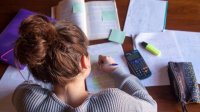5 Ways to Help Neurodiverse Students Improve Executive Function Skills
Neurodiverse students often struggle with organization in middle and high school, but they can be successful with the proper supports.
Your content has been saved!
Go to My Saved Content.Learning is the journey the brain takes when acquiring new information, and executive functioning is a critical component of this learning journey. Executive function skills require students to utilize memory, self-control, and attention flexibly to follow directions, plan, and multitask. Consequently, developing these skills is critical for students in secondary grades.
Secondary and postsecondary success often requires students to manage multiple tasks and courses, plan out completion of long-term projects, and set and reach ambitious goals. However, these skills can be challenging for secondary students to refine and master.
Students with disabilities are even more likely to grapple with executive dysfunction, particularly those with a diagnosis of attention deficit disorder and attention deficit hyperactivity disorder.
Neurodiverse students’ executive functioning skills are an often-overlooked area of need during individualized education program (IEP) development. When we design accommodations and modifications, and engage in secondary transition planning, it’s often related to supporting students’ executive functioning skills to access the instruction.
For example, a student may have an accommodation that requires directions to be read aloud. This is a skill that can support students in comprehending and carrying out multiple steps. Students with and without disabilities can often benefit from explicit supports related to executive functioning. These skills can make the difference in students’ ability to successfully navigate college, trade school, and independent life after graduation.
As a special educator, I’d say it’s our responsibility to lead the charge in our schools by providing opportunities for all students to learn, practice, and refine executive function skills.
Executive dysfunction almost always plagues students with disabilities who are served via IEPs and 504 plans. However, all students can benefit from explicit executive functioning assistance. As such, I’m challenging special educators to lead the way in this area of instruction—let’s teach students to manage themselves and the demands of life alongside the content of literacy, math, STEM, and history, etc.
5 Ways to Support Building Executive Function Skills
1. Bring your directions to life. Think aloud. There is power in narrating your thought processes when sharing expectations, organizing an equation, or annotating information. Consider how your lesson requires students to complete multistep directions. How can you break this direction down and model it aloud? Maybe today’s independent task requires students to organize information from a passage. How can you bring this task to life? Think aloud.
2. Graphic organizers are your friend. Always provide students with options of graphic organizers to use when completing assignments independently. This will allow them access to tools for organizing and synthesizing information. Always model how to use these organizers with real tasks in your class. You may choose to make graphic organizers available via hard copy in your classroom or in a shared digital folder for students to access at all times.
3. Leverage technology. Use media, images, and video to provide visual exemplars of ways to organize information, plan tasks, and set goals. You could let your students see examples of how others annotate text in unique ways. In math, provide multiple ways that students can organize information in a multistep math word problem or use math journals to support students in organizing daily notes and content.
4. Incorporate executive functioning into grading. Consider allowing students to earn points toward an assignment or in a given course by applying executive function skills. For example, students may be able to receive additional points for a cumulative assignment by turning in a copy of the outline and short-term goals they created as they planned out the assignment.
Incorporating executive functioning into the grading system can encourage goal-oriented students to practice and apply these skills to support their success.
5. Use apps. There are limitless options of applications that allow for managing lists, utilizing timers, generating reminders, setting goals, and organizing information. Be sure to share them with parents and students, with permission. If appropriate, you may even choose to allow students to utilize the apps during class time.
As we support teenage students in refining their executive functioning skills, our classrooms should be safe spaces for them to explore a variety of strategies and figure out what works best for them. Creating these safe spaces to counter executive dysfunction can and should include the use of high-, low-, and no-tech strategies that students can access independently.
Beyond the five strategies listed, teachers can utilize everyday items like sticky notes, note cards, clocks, timers, calendars, labels, and even simple writing utensils to model executive function skills for students throughout the day.
A high school student’s ability to self-regulate in the area of executive functioning can make or break their ability to balance life beyond graduation. Executive functions like attention, memory, time management, and organization are all everyday skills that we must independently manage in our lives. Special education teachers especially must not overlook conversations about students’ skills in this area at IEP meetings, particularly when developing postsecondary transition goals.
For our growing and evolving students, executive functioning is a nonnegotiable component of learning, independence, and flourishing after high school.
